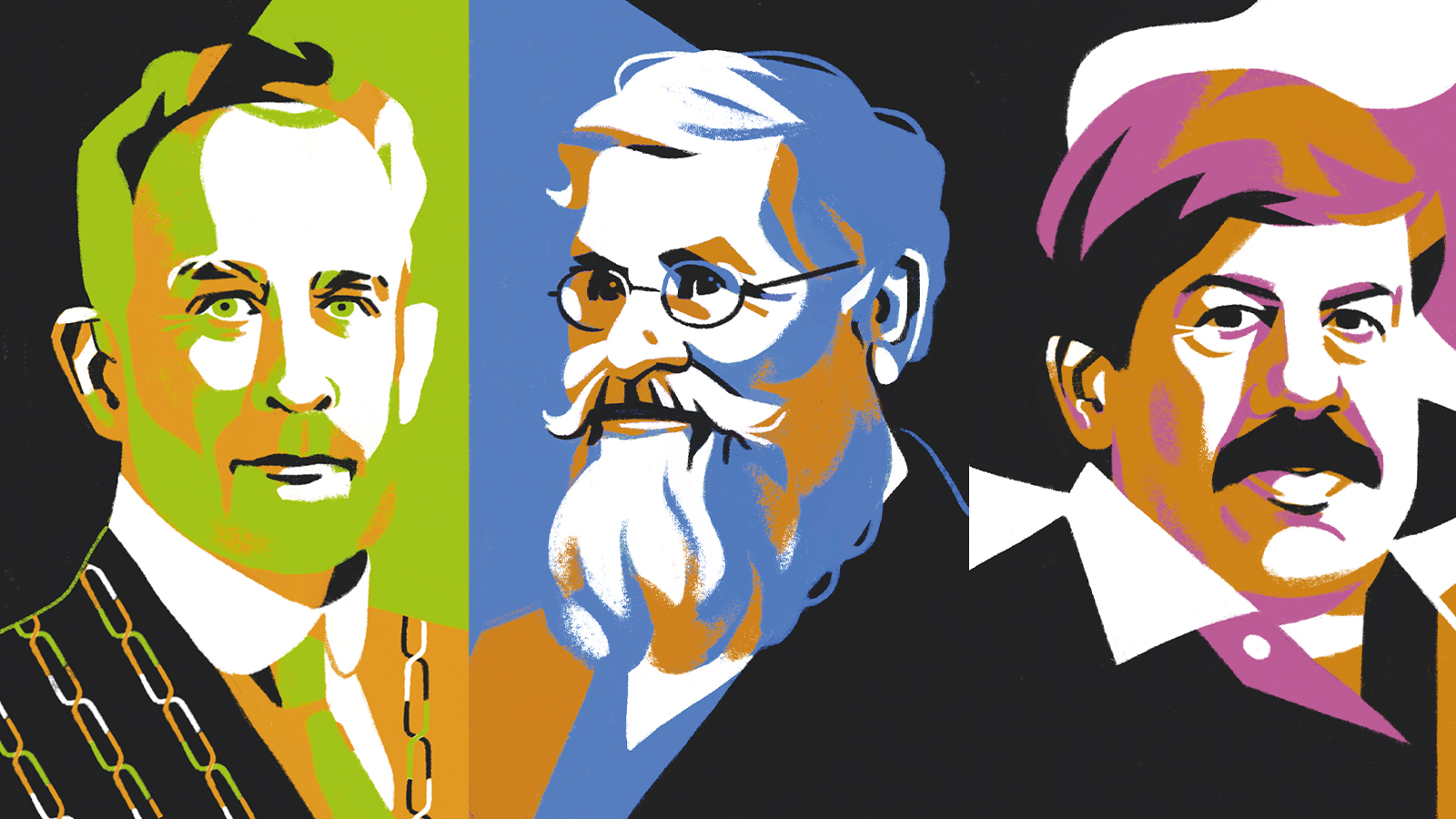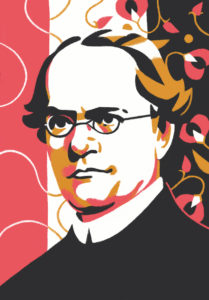Alternative progress
Darwin is lauded as the father of evolution, but these thinkers show us different options.
by Paolo Frosina


Imagine developing a cornerstone theory of modern science, and yet people use another scientist’s name when talking about it.
ALFRED RUSSEL WALLACE (1823-1913)
That happened to Alfred Russel Wallace, who independently conceived of the theory of evolution through natural selection—what we’re used to calling “Darwinism.” Born in Wales, the eighth of nine brothers, Alfred started collecting insects at age 22, while working in the countryside as a land surveyor. A strong believer in the transmutation of species—the altering of one species into another—in 1848 he decided to leave Wales for the Amazonian rainforest, where he stayed four years, collecting specimens and selling some of them to museums to fund his trip. In 1854, he left again, travelling for seven years through the Malay Archipelago and collecting more than 126,000 specimens, mostly beetles. There, he wrote his essay On the law which has regulated the introduction of new species, drawing the conclusion that “Every species has come into existence coincident both in space and time with a closely allied species,” from which it evolves. He started corresponding with Darwin, who was working on the same research for decades but had not yet published it. In February 1858, Wallace sent Darwin his On the Tendency of Varieties to Depart Indefinitely From the Original Type essay, where he theorized natural selection, although never using that term. Darwin found the work so similar to his own writings that he decided to send them both to the Linnean Society of London, where they were presented jointly on July 1, 1858. One year later, Darwin published On the Origin of Species, which is considered to be the foundational work of evolutionary biology.
GREGOR JOHANN MENDEL (1822-1884)

The Augustinian friar famous for inventing genetics from peas was born–named only Johann—in Silesia in the Austrian Empire. During his childhood he worked as a beekeeper, a passion he cultivated his whole life. He struggled to pay for his physics studies, and became a friar because that enabled him to earn a degree without having to pay for it. When he joined the Augustinians, he was given the name Gregor. At St. Thomas’s Abbey in Brno, Czech Republic he began his studies on heredity using mice, but his bishop did not like that one of his friars was studying the animal sex, so Mendel switched to plants, starting experiments on edible peas. Between 1856 and 1863 he cultivated and tested some 28,000 plants. Mendel worked with seven characteristics of the pea plant: height, pod shape and color, seed shape and color, and flower position and color. Taking seed color as an example, he showed that when a true-breeding yellow pea and a true-breeding green pea were crossbred, their offspring always produced yellow seeds. However, in the next generation, the green peas reappeared at a ratio of one green to three yellow. To explain this phenomenon, Mendel coined the terms ‘recessive’ and ‘dominant’ in reference to certain traits: the green trait—which seems to have vanished in the first filial generation—is recessive, while the yellow, is dominant. He published his work (Experiments on Plant Hybridization) in 1866, demonstrating the actions of invisible factors—now called genes—in predictably determining the traits of an organism. Nevertheless, the paper was largely ignored by the scientific community, cited only three times in the next 35 years.
THOMAS HUNT MORGAN (1866–1945)

Mendel’s work on peas was rediscovered around 1900, and with it, the foundation of genetics. At the time, Thomas Hunt Morgan—born in Lexington, Kentucky, in the same year in which Mendel published his main research—was a professor in experimental zoology at Columbia University in New York. During his career, Morgan became increasingly focused on the mechanisms of heredity and evolution: He was, nonetheless, initially skeptical of Mendel’s laws of heredity, as well as the related chromosomal theory of sex determination. With his experimental heredity work, Morgan was seeking to prove Hugo De Vries’ theory that new species were created by mutation. Around 1908, he started working on the fruit fly Drosophila melanogaster, encouraging students to follow him. He mutated Drosophila through physical, chemical, and radiational means, beginning cross-breeding experiments to find heritable mutations, with no significant success for two years. Then, in 1910, he bred mutant white-eyed flies with normal red-eyed females. Their progeny were all red-eyed, but second generation cross produced white-eyed males: A sex-linked recessive trait, which displayed Mendelian inheritance patterns. In a paper published in Science magazine in 1911, Morgan concluded that some traits were sex-linked, that the trait was probably carried on one of the sex chromosomes, and that other genes were probably carried on specific chromosomes as well. Morgan’s Fly Room at Columbia became world-famous, and he found it easy to attract funding and visiting scholars: The Fly Room is also a 2014 independent film based on the story of Calvin B. Bridges, one of the scientists who worked on Morgan’s team.
STEPHEN JAY GOULD (1941–2002)

One of the most influential authors of popular science, Stephen Jay Gould—born in Queens, New York, from a Jewish mother and a Marxist, war veteran father—spent most of his career teaching at Harvard University. He was a palaeontologist, evolutionary biologist, and science historian. In his 1996 book, Full House: The Spread of Excellence from Plato to Darwin, he favored the argument that evolution has no inherent drive towards long-term “progress.” Even if commentary often portrayed evolution as a ladder of progress—leading towards more complex and ultimately more “human-like” organisms—Gould argued that evolution’s drive was not towards complexity, but towards diversification. Given that life is constrained to begin with a simple starting point (like bacteria), any diversity resulting from this start, by random movement, will have a skewed distribution, and therefore be perceived to move in the direction of higher complexity. But life, Gould said, can also easily adapt towards simplification, as is often the case with parasites. Evolutionary biologist, Richard Dawkins, in reviewing Full House, suggested that he saw evidence of a “tendency for lineages to improve cumulatively their adaptive fit to their particular way of life, by increasing the numbers of features which combine in adaptive complexes.” “By this definition, concluded Dawkins, adaptive evolution is not just incidentally progressive, it is deeply, dyed-in-the-wool, indispensably progressive.”



 in Italy
in Italy